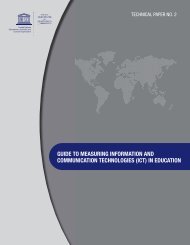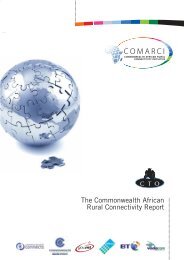Transforming education: the power of ICT policies - Commonwealth ...
Transforming education: the power of ICT policies - Commonwealth ...
Transforming education: the power of ICT policies - Commonwealth ...
Create successful ePaper yourself
Turn your PDF publications into a flip-book with our unique Google optimized e-Paper software.
to <strong>the</strong> country’s shift towards sustainable development is <strong>the</strong> prominence given by Government leadership to <strong>ICT</strong><br />
in general and in <strong>education</strong> in particular.<br />
Socio-economic Pr<strong>of</strong>i le<br />
Rwanda is a small, landlocked country i n Central Africa with 10.7 million people and a population growth <strong>of</strong> 2.87%<br />
per annum. The indigenous population consists <strong>of</strong> three ethnic groups: <strong>the</strong> Hutus who comprise <strong>the</strong> majority <strong>of</strong> <strong>the</strong><br />
population (85%), <strong>the</strong> Tutsis (14%) and <strong>the</strong> Twa (1%). Table 1 below provides demographic indicators for Rwanda.<br />
Table 1: Demographic Indicators Rwanda, 2009<br />
Indicator Performance<br />
Population 10.7 million (2009)<br />
Population Density 368 per square km (2008)<br />
Population Growth Rate 2.87% pa (2009)<br />
Age Structure 0–14 years: 42.7%; 15–64: 54.8%<br />
Median Population Age 18.7 years (2009)<br />
Life Expectancy 56.77 years (2009)<br />
Infant Mortality<br />
67.18 deaths for every 1,000 live births<br />
(2009)<br />
% Urban Population 18% (2008)<br />
Source: CIA, World Factbook, Rwanda, 2010<br />
Table 1 shows that Rwanda has a very young, predominantly rural population and features among <strong>the</strong> most densely<br />
populated countries in Africa with 368 people per square kilometre.<br />
Rwanda is also one <strong>of</strong> <strong>the</strong> fastest growing economies in Africa. Economic growth rates have averaged 5.8% per annum<br />
over <strong>the</strong> past ten years; and in 2007 it grew by 7.9% in 2007 and 8.5% in 2008. Between 1980 and 2007 Rwanda’s<br />
Human Development Index (HDI) rose by 0.94% annually from 0.357 to 0.460 today, which is one indication <strong>of</strong> <strong>the</strong><br />
country’s progress over time. Increased productivity in <strong>the</strong> agricultural and service sectors, toge<strong>the</strong>r with strong<br />
public and private sector investment, have been <strong>the</strong> main sources <strong>of</strong> growth, employment and poverty reduction in<br />
<strong>the</strong> short to medium term (World Bank, 2009).<br />
Rwanda is also reportedly on track to achieve MDG 2 on universal primary <strong>education</strong>, MDG 3 on gender equality and<br />
MDG 6 on HIV/AIDS and malaria. Net primary enrolment (2007) is 95%, with 97% enrolment <strong>of</strong> girls. HIV prevalence<br />
is estimated at about 3% with female infection rates (3.6%) substantially higher than those <strong>of</strong> males (2.3%). Rwanda<br />
is also on track to achieve <strong>the</strong> targeted reduction in malaria incidence. Table 2 provides indicators <strong>of</strong> Rwanda’s<br />
socio-economic development.<br />
Table 2: Socio-economic Indicators, 2007<br />
Human Development Index (HDI) 1 0.460 (2007), ranking 167th out <strong>of</strong> 182 countries;<br />
Human Poverty Index (HPI) 32.9%, ranking 100th out <strong>of</strong> 135 countries<br />
Per Capita Gross National Income in US Dollars $200 (2003), $230 (2005), $330 (2007) 2<br />
Source: Human Development Report, 2009<br />
Despite <strong>the</strong> signifi cant growth and progress however, Rwanda is still predominantly an underdeveloped agrarian<br />
economy with approximately 60% <strong>of</strong> its population reportedly living under <strong>the</strong> poverty line (GoR, 2000). The economy<br />
still suffers a host <strong>of</strong> structural challenges such as <strong>the</strong> low use <strong>of</strong> modern inputs and lack <strong>of</strong> extension services in<br />
170 | <strong>Transforming</strong> Education: The Power <strong>of</strong> <strong>ICT</strong> Policies
















